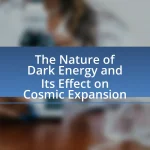The life cycle of stars encompasses several critical stages, including stellar formation, the main sequence phase, and eventual transformations into red giants, supergiants, or remnants such as white dwarfs, neutron stars, or black holes. Stars originate from nebulae, where gas and dust collapse under gravity to form protostars, leading to nuclear fusion and stability during the main sequence. The article details the processes of star formation, the mechanisms of nuclear fusion, and the evolutionary outcomes based on stellar mass, including the explosive phenomena of supernovae and their implications for the cosmic ecosystem. Observational techniques and tools used in stellar astronomy are also discussed, highlighting their role in enhancing our understanding of stellar evolution and the formation of elements essential for life.

What is the life cycle of stars?
The life cycle of stars consists of several stages: stellar formation, main sequence, red giant or supergiant phase, and ultimately, the end stages which can result in a white dwarf, neutron star, or black hole. Stars begin as clouds of gas and dust, known as nebulae, which collapse under gravity to form protostars. Once nuclear fusion ignites in the core, the star enters the main sequence phase, where it spends the majority of its life fusing hydrogen into helium.
As hydrogen depletes, the star evolves into a red giant or supergiant, depending on its mass. In this phase, helium and heavier elements are fused in the core. The end of a star’s life cycle varies: low to medium mass stars shed their outer layers and leave behind a white dwarf, while massive stars undergo supernova explosions, leading to neutron stars or black holes. This process is supported by observational data from telescopes and studies of stellar evolution, such as those conducted by the Hubble Space Telescope and research published in astrophysical journals.
How do stars form from cosmic materials?
Stars form from cosmic materials through a process called stellar nucleosynthesis, which begins in molecular clouds composed of gas and dust. These clouds, primarily made of hydrogen, collapse under their own gravity, leading to an increase in density and temperature. As the core of the collapsing cloud becomes sufficiently hot and dense, nuclear fusion reactions initiate, converting hydrogen into helium and releasing energy. This energy creates an outward pressure that balances the gravitational collapse, resulting in the formation of a protostar. Over time, as fusion continues and the protostar accumulates more mass, it eventually reaches the main sequence phase, where it becomes a stable star. This process is supported by observations of star formation in regions like the Orion Nebula, where dense regions of gas and dust are actively forming new stars.
What are the stages of star formation?
The stages of star formation include molecular cloud formation, protostar development, main sequence star phase, and eventual stellar evolution. Initially, a molecular cloud, composed of gas and dust, collapses under its own gravity, leading to the formation of a protostar. As the protostar accumulates mass, it heats up and eventually reaches temperatures sufficient for nuclear fusion, marking its entry into the main sequence phase. During this phase, the star fuses hydrogen into helium, maintaining stability for millions to billions of years. After exhausting its hydrogen fuel, the star undergoes further evolution, which can lead to various outcomes such as becoming a red giant or supernova, depending on its mass. This progression is supported by observational data from telescopes that track the lifecycle of stars in various stages across the universe.
How do protostars develop into main sequence stars?
Protostars develop into main sequence stars through a process of gravitational contraction and nuclear fusion. Initially, a protostar forms from a dense region of gas and dust in a molecular cloud, where gravity causes the material to collapse and heat up. As the protostar continues to accumulate mass, its core temperature rises, eventually reaching approximately 10 million Kelvin. At this critical temperature, hydrogen nuclei begin to fuse into helium, releasing energy that counteracts gravitational collapse. This balance between gravitational forces and the outward pressure from nuclear fusion marks the transition to the main sequence phase, where the star will spend the majority of its life. The process is supported by observational evidence from stellar evolution models and the Hertzsprung-Russell diagram, which illustrates the relationship between a star’s luminosity and temperature, confirming that stars spend significant time in the main sequence stage after forming from protostars.
What defines the main sequence phase of a star?
The main sequence phase of a star is defined by the process of hydrogen fusion occurring in its core, where hydrogen atoms combine to form helium, releasing energy that balances gravitational forces. This phase represents the longest stage in a star’s life cycle, typically lasting billions of years, during which the star maintains a stable size and temperature. For example, our Sun has been in the main sequence phase for approximately 4.6 billion years and is expected to remain in this phase for about another 5 billion years, illustrating the stability and longevity characteristic of main sequence stars.
How does nuclear fusion occur in main sequence stars?
Nuclear fusion in main sequence stars occurs primarily through the proton-proton chain reaction, where hydrogen nuclei (protons) fuse to form helium. This process takes place in the core of the star, where extreme temperatures (around 15 million Kelvin) and pressures enable protons to overcome their electrostatic repulsion. During fusion, energy is released in the form of gamma rays, which contributes to the star’s luminosity and stability. The energy produced by fusion balances the gravitational forces trying to collapse the star, maintaining hydrostatic equilibrium. This mechanism is fundamental to the life cycle of stars, as it sustains their energy output for billions of years.
What factors influence a star’s position on the Hertzsprung-Russell diagram?
A star’s position on the Hertzsprung-Russell diagram is primarily influenced by its temperature, luminosity, and evolutionary stage. The temperature determines the color and spectral type of the star, while luminosity reflects the total energy output. For instance, hotter stars appear on the left side of the diagram, while cooler stars are found on the right. Additionally, a star’s evolutionary stage, such as whether it is a main-sequence star, red giant, or white dwarf, further dictates its placement. Main-sequence stars, which fuse hydrogen into helium, occupy a diagonal band from the upper left to the lower right, while red giants are located in the upper right due to their high luminosity and lower temperatures. This classification is supported by observational data from various star catalogs, which consistently show these trends across different stellar populations.
What happens to stars after the main sequence phase?
After the main sequence phase, stars undergo significant changes based on their mass. Low to medium-mass stars, like our Sun, expand into red giants, shedding outer layers and forming planetary nebulae, while their cores contract into white dwarfs. High-mass stars, on the other hand, evolve into supergiants, eventually leading to supernova explosions, which can result in neutron stars or black holes. This progression is supported by stellar evolution theories, which detail the life cycles of stars and the processes involved in their transformations.
How do stars evolve into red giants or supergiants?
Stars evolve into red giants or supergiants primarily through the process of nuclear fusion and changes in their core structure as they exhaust hydrogen fuel. During the main sequence phase, stars fuse hydrogen into helium in their cores. Once hydrogen is depleted, the core contracts under gravity, increasing temperature and pressure, which eventually allows helium fusion to occur. This process leads to the expansion of the outer layers of the star, transforming it into a red giant.
For more massive stars, the evolution continues as they undergo successive stages of fusion, creating heavier elements until they reach iron. This results in the formation of supergiants, characterized by their larger size and luminosity compared to red giants. The transition from red giant to supergiant is marked by the star’s ability to fuse heavier elements, which is a critical factor in their evolutionary path.
What processes lead to the formation of heavier elements in stars?
Heavier elements in stars are formed primarily through nuclear fusion processes, specifically during the later stages of stellar evolution. In massive stars, hydrogen fuses into helium through the proton-proton chain or the CNO cycle, and as the star evolves, it undergoes successive fusion processes where helium fuses into carbon and oxygen, followed by the fusion of these elements into heavier elements like neon, magnesium, and silicon.
During supernova explosions, the extreme temperatures and pressures facilitate rapid neutron capture processes, known as the r-process, which create even heavier elements such as gold and uranium. This is supported by observations of supernova remnants and the abundance of heavy elements in the universe, indicating that these processes are responsible for the synthesis of elements beyond iron in the periodic table.
How do stars end their life cycle?
Stars end their life cycle through processes that depend on their mass. Low to medium-mass stars, like our Sun, expand into red giants and ultimately shed their outer layers, creating planetary nebulae, while their cores collapse into white dwarfs. High-mass stars, on the other hand, undergo a more violent end, exploding in supernovae, which can leave behind neutron stars or black holes. This distinction is supported by stellar evolution theories, which outline that the mass of a star determines its final stages and remnants, as detailed in studies of stellar nucleosynthesis and supernova mechanics.
What are the different outcomes for stars of varying masses?
Stars of varying masses have distinct evolutionary outcomes. Low-mass stars, like our Sun, typically evolve into red giants and eventually shed their outer layers, forming planetary nebulae, while their cores become white dwarfs. In contrast, high-mass stars undergo more dramatic transformations; they can explode as supernovae after exhausting their nuclear fuel, leaving behind neutron stars or black holes. This differentiation in outcomes is supported by stellar evolution models, which illustrate that mass determines the fusion processes and end states of stars.
How does a star become a supernova?
A star becomes a supernova when it exhausts its nuclear fuel and undergoes a catastrophic collapse. In massive stars, this process occurs after they have fused elements up to iron in their cores, leading to an imbalance between gravitational forces and internal pressure. Once the core collapses, it triggers a rebound effect that causes the outer layers to explode outward, resulting in a supernova. This phenomenon is supported by observations of supernova remnants, such as the Crab Nebula, which provide evidence of the explosive end stages of massive stars.
What are the implications of a supernova event?
A supernova event has significant implications for the surrounding environment and the broader cosmos. It can lead to the dispersal of heavy elements into space, enriching the interstellar medium and contributing to the formation of new stars and planets. For instance, supernovae are responsible for creating elements like gold and uranium, which are essential for the development of life as we know it. Additionally, the shock waves generated by a supernova can trigger the collapse of nearby gas clouds, initiating the birth of new stars. Historical observations, such as the Crab Nebula, which is the remnant of a supernova explosion recorded in 1054 AD, illustrate the transformative effects of such events on galactic evolution.
How do supernovae contribute to the cosmic ecosystem?
Supernovae contribute to the cosmic ecosystem by dispersing heavy elements into space, enriching the interstellar medium. When a massive star undergoes a supernova explosion, it ejects materials such as carbon, oxygen, and iron, which are essential for the formation of new stars and planets. This process not only recycles stellar material but also triggers the formation of new stars by compressing surrounding gas and dust. Historical observations, such as the Crab Nebula, demonstrate how supernova remnants continue to influence star formation in their vicinity, showcasing the vital role supernovae play in the ongoing cycle of matter in the universe.
What remnants are left after a supernova explosion?
After a supernova explosion, the remnants typically include a neutron star, a black hole, or a supernova remnant composed of gas and dust. Neutron stars are formed when the core of a massive star collapses under gravity, resulting in an incredibly dense object primarily made of neutrons. If the core’s mass exceeds a certain limit, it may collapse further into a black hole. The supernova remnant consists of the expelled outer layers of the star, which expand into space and can trigger the formation of new stars. These remnants are observable and provide critical insights into stellar evolution and the chemical enrichment of the universe.
How can we observe and study the life cycle of stars?
We can observe and study the life cycle of stars through various astronomical techniques, including spectroscopy, photometry, and imaging with telescopes. Spectroscopy allows scientists to analyze the light emitted by stars, revealing their composition, temperature, and stage in the life cycle. For instance, the Hubble Space Telescope has provided detailed spectra of stars, helping to identify their evolutionary phases. Photometry measures the brightness of stars over time, enabling the detection of changes that indicate different life stages, such as the transition from main sequence to red giant. Additionally, imaging techniques, such as those used in the Kepler Space Telescope, allow for the observation of star formation in nebulae and the dynamics of supernovae, providing insights into the end stages of stellar evolution. These methods collectively enhance our understanding of how stars are born, evolve, and ultimately die.
What tools and methods are used in stellar astronomy?
Stellar astronomy utilizes telescopes, spectrometers, and photometers as primary tools, alongside methods such as photometry, spectroscopy, and astrometry. Telescopes, including optical and radio varieties, allow astronomers to observe celestial objects, while spectrometers analyze the light emitted or absorbed by stars to determine their composition, temperature, and velocity. Photometers measure the brightness of stars over time, enabling the study of variable stars and exoplanets. Astrometry, the precise measurement of star positions and movements, helps in understanding stellar distances and dynamics. These tools and methods are essential for investigating the life cycle of stars, from their formation in nebulae to their eventual supernova explosions.
How do observations of different star types enhance our understanding of stellar evolution?
Observations of different star types enhance our understanding of stellar evolution by providing critical data on their life cycles, compositions, and end states. For instance, studying massive stars reveals insights into supernova mechanisms and the formation of neutron stars or black holes, while observations of low-mass stars help scientists understand the processes leading to red giants and planetary nebulae. The Hertzsprung-Russell diagram, which categorizes stars based on their luminosity and temperature, illustrates the evolutionary paths of various star types, confirming theoretical models of stellar life cycles. Additionally, the discovery of exoplanets around different star types has expanded knowledge about the conditions necessary for life, further linking stellar evolution to planetary systems.
What practical insights can we gain from studying the life cycle of stars?
Studying the life cycle of stars provides practical insights into the formation of elements essential for life and the dynamics of galaxies. The process of stellar nucleosynthesis, occurring during various stages of a star’s life, leads to the creation of heavier elements from hydrogen and helium, which are crucial for the development of planets and biological organisms. For instance, elements like carbon, oxygen, and iron are formed in the cores of stars and distributed throughout the universe when stars explode as supernovae, enriching the interstellar medium. This understanding helps astronomers trace the chemical evolution of galaxies and the origins of the elements found on Earth. Additionally, studying stellar life cycles enhances our knowledge of cosmic events, such as supernovae and black hole formation, which have significant implications for understanding the universe’s structure and evolution.

